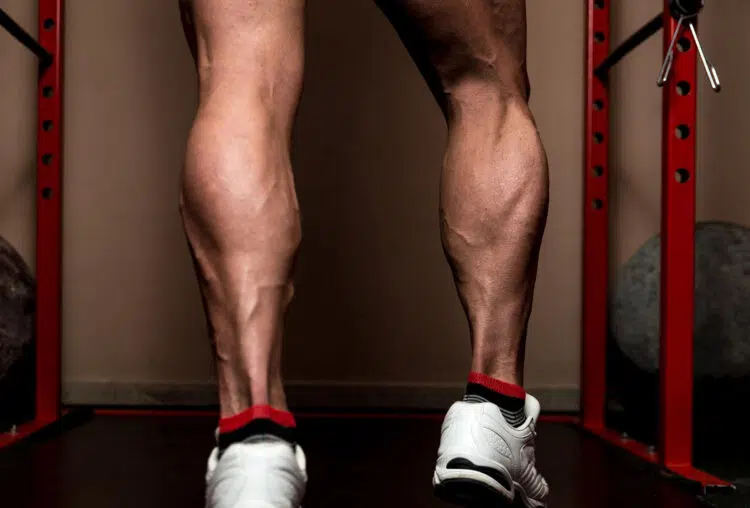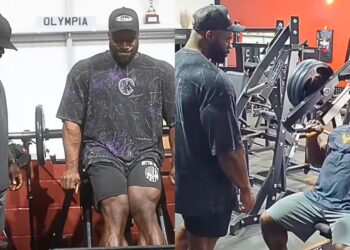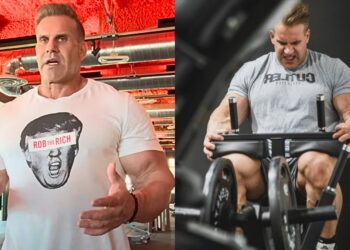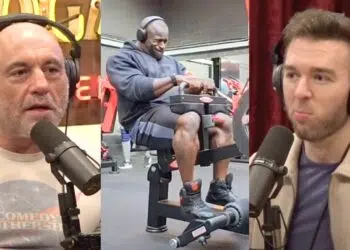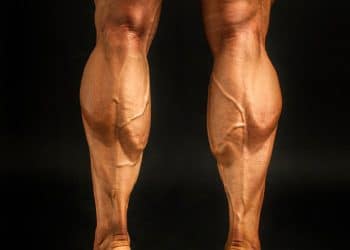According to gym lore, the calves are one of the hardest muscles to build. A lot of exercisers blame their genetics for their underwhelming calves, but I think there is another reason that so many lifters can’t get their calves to grow.
I’ve been a personal trainer for more than three decades and in my opinion, the reason that people find the calves so tough to develop is their choice of exercises.
Ask any gym goer to name as many chest exercises as they can, and they’ll probably be able to list a dozen or more. The same is true for the back, biceps, and shoulders. But, ask them to name more than a few calf exercises and most will struggle.
That’s not to say that there is anything wrong with the classic seated and standing calf raises. However, if those are the only exercises you ever do for your calves, it shouldn’t be surprising that your calf growth has come to a grinding halt.
After all, what do you suppose would happen if all you did for your biceps was standing dumbbell and barbell curls? A progress plateau is all but guaranteed!
Unfortunately, a lot of people don’t know many calf exercises. Consequently, their lower leg workouts lack the variety they need to build bigger, stronger calves. Studies suggest that exercise variety can help contribute to better training results, provided it’s planned and well-structured (1, 2).
Level Up Your Fitness: Join our 💪 strong community in Fitness Volt Newsletter. Get daily inspiration, expert-backed workouts, nutrition tips, the latest in strength sports, and the support you need to reach your goals. Subscribe for free!
In this article, I reveal five lesser-known calf exercises and share three tried-and-tested workouts to blast you out of your calf-training rut.
5 Calf Exercises That Most People Don’t Know
Are you bored of doing endless sets of seated and standing calf raises? Has your calf development plateaued? Breathe new life into your lower leg workouts with these lesser-known calf exercises!
1. Squat Hold Calf Raises
Conventional seated and standing calf raises are great exercises for loading your calves. However, the muscles in your lower legs also play a crucial role in stabilizing your ankles. Adding an element of instability to your calf training will help tap into the fibers that might otherwise go unstimulated.
That’s not to say you should start doing your calf raises on a stability ball. However, exercises that challenge your balance may be the key to unlocking new muscle growth. Squat hold calf raises were a favorite of Mr. Olympia competitor Lee Priest, who was well-known for his muscular, shapely calves.
Steps:
- Stand with your feet about shoulder-width apart.
- Descend into a deep squat so you are sitting on your heels.
- Without standing up, rise onto your tiptoes and then lower your heels back to the floor.
- Continue until your calves are pumped and burning.
Tips:
- Hold into a railing, squat rack, or nearby machine for balance if required.
- Too easy? Add some weight by resting a dumbbell or weight plate on your knees.
- Try doing this exercise without shoes so you can really drive the balls of your feet into the floor and maximize calf engagement.
2. Tiptoe Farmer’s Carry
Even as a child, I had fairly large, strong calves. This is despite not doing any specific exercises for my lower legs. I believe the reason for this was my habit of walking around the house on tiptoes. Walking on tiptoes puts a lot of stress on your calves, providing a unique workout for these hard-to-develop muscles.
Many years later, I learned that bronze and silver-era bodybuilders did something similar, which they called the goosestep. A better, more modern name for this exercise is tiptoe farmer’s carries.
Steps:
- Hold a heavy dumbbell or kettlebell in each hand.
- Rise up onto your tiptoes.
- Keeping your heels off the ground, go for a walk around your training area.
- Continue until you are unable to keep your heels up.
Tips:
- You can also do this exercise with a barbell on your back, which may allow you to use even heavier weights.
- Use gym chalk and lifting straps to ensure that your hands don’t fail before your calves.
- Take small steps – how far you walk is less important than the number of steps.
3. Explosive Calf Raises
You don’t have to give up doing traditional calf raises to beef up your lower legs. However, you may want to adjust your form to make them more effective.
In most training articles, you are told to do your reps slowly and smoothly. However, the fibers that make up the calves are often mainly fast twitch (type 2b) in nature, meaning they’re made for rapid, explosive movements (3). Consequently, slow reps may not be the best way to make them bigger.
Doing explosive calf raises might seem like cheating but, trust me, the post-workout soreness produced by this exercise suggests that they work your calves in a very unique way.
Steps:
- Stand on the footplate of your calf raise machine so the balls of your feet are on the edge and your heels are free to move.
- Place your shoulders under the pads and stand up. Brace your core.
- Bend your knees slightly and descend into a shallow squat while simultaneously lowering your heels toward the floor.
- Explosively extend your knees and drive up onto your tiptoes.
- Lower your heels back down, bend your knees, and repeat.
- Continue until you are unable to lift the weight explosively.
Tips:
Level Up Your Fitness: Join our 💪 strong community in Fitness Volt Newsletter. Get daily inspiration, expert-backed workouts, nutrition tips, the latest in strength sports, and the support you need to reach your goals. Subscribe for free!
- Lower your heels slowly and to a full stretch to maximize the effectiveness of this exercise.
- Start by using 50-60% of your usual standing calf raise weight. Increase gradually as you become used to the exercise.
- You can also do this exercise with dumbbells or a barbell, making it ideal for home workouts:
4. Steep Uphill Walking
I’m an ardent hiker and I can tell you that hill walking is a great cardio and calf workout, especially when you’ve got a heavily loaded pack on your back. Based on this experience, I started doing uphill walking in my leg workouts and my calves responded really well.
However, you’ll need to crank up the incline and modify your walking style to make this exercise as effective as possible. I like to use this uphill walking as a finisher at the end of my leg workouts; the pump is unreal!
Steps:
- Climb aboard your treadmill and start walking at a moderate pace, e.g., 2-3 miles per hour.
- Raise the incline to about 8-10%
- Walk by pressing your heels down and back to stretch your calves and pushing hard off the balls of your feet. Imagine you are trying to show the soles of your feet to someone behind you.
- Continue until your calves are pumped and burning.
Tips:
- Wear a weighted vest or carry dumbbells to make this exercise even more effective.
- Use blood flow restriction cuffs around your upper calves to reduce the oxygen being delivered to your muscles and get an even better calf workout.
- No treadmill? No problem? Walk up some outdoor hills instead.
5. Dip Belt Donkey Calf Raises
The donkey calf raise was a popular lower leg exercise during the golden era of bodybuilding. You may even have seen pictures of Arnold Schwarzenegger doing this exercise with multiple training partners sitting on his back!
While I’m not a fan of doing this exercise with human weights, I do think that dip belt donkey calf raises are a great if underutilized exercise for building bigger calves.
The reason for this is that the main calf muscle – the gastrocnemius – is biarticular, meaning it crosses two joints, namely the ankle and the knee. Donkey calf raises provide your gastroc muscles with a deep stretch, which research suggests can enhance hypertrophy or growth (4).
- Put on your dip belt and load it with an appropriate weight.
- Place the balls of your feet on the edge of a step so your heels are free to move.
- Keeping your legs mostly straight, lean forward and rest your hands on a sturdy bench. Your torso should be roughly parallel to the floor.
- Lower your heels toward the floor to stretch your calves and then rise up onto your tiptoes.
- Continue for the prescribed number of reps and sets
Tips:
- Make sure your dip belt is sitting across your hips and not your lower back.
- Turn your feet in to emphasize your outer (lateral head) calves, or out to hit your inner (medial head) calves more.
- No dip belt? No problem! Make like Arnie and recruit a training partner, although this is NOT my preferred way to do this exercise:
Unconventional Workouts for Bigger Calves
While any of these exercises could help you build bigger calves, you’ll get better results if you incorporate them into a routine. While there is nothing to stop you from writing your own program, here are three workouts that you can start using right away.
Train your calves twice a week – once isn’t enough. But, before you begin, make sure you warm up thoroughly to reduce your risk of injury and improve workout performance and effectiveness.
All set and ready to go? Then let’s do it!
Workout #1 – The Kitchen Sink Calf Routine
This workout combines all of the exercises shared in this article. Hitting your calves from all available angles will leave no muscle fiber unstimulated. The variety will also help ward off boredom.
| Exercise | Sets | Reps | Recovery | |
| 1a | Squat hold calf raises | 2-3 | 15-20 | 90 seconds |
| 1b | Explosive calf raises | 8-12 | ||
| 2 | Dip belt donkey calf raises | 2-3 | 8-12 | 90 seconds |
| 3 | Tiptoe farmer’s walk | 2-3 | 45-60 seconds | 60 seconds |
| 4 | Steep uphill walking | 1 | 5 minutes | n/a |
Exercises 1a and 1b are a superset. Do one set of squat hold calf raises immediately followed by a set of explosive calf raises. Rest for 90 seconds and then repeat the pairing a couple more times.
Workout #2 – Home Calf Routine
Training at home is no excuse for having small calves. In fact, not having access to the standard seated and standing calf raise machines could even be seen as a blessing because it will force you to train your lower legs with lesser-known exercises.
| Exercise | Sets | Reps | Recovery | |
| 1 | Explosive calf raises* | 2-3 | 12-15 | 60 seconds |
| 2 | Squat hold calf raises | 2-3 | 15-20 | 60 seconds |
| 3 | Tiptoe farmer’s walk | 2-3 | 30-40 seconds | 60 seconds |
*Use dumbbells.
Workout #3 – Calf Routine for Athletes
While there is nothing wrong with wanting bigger calves so you look better in shorts, athletes are usually more concerned with function and performance than aesthetics. This workout is designed to help you run faster and jump higher.
| Exercise | Sets | Reps | Recovery | |
| 1 | Dip belt donkey calf raises | 2-3 | 10-12 | 60 seconds |
| 2 | Explosive calf raises | 2-3 | 8-10 | 90 seconds |
| 3 | Squat hold calf raises | 2-3 | 15-20 | 60 seconds |
| 4 | Steep uphill walking | 2-3 | 90 seconds | 60 seconds |
Closing Thoughts
Few things are more frustrating than training hard but not getting good results. Not only is it a waste of your valuable time and energy, but going nowhere fast can also eat away at your motivation.
So, don’t undermine your workouts by overusing conventional seated and standing calf raises. While they are not bad exercises, you can have too much of a good thing.
Instead, breathe new life into your lower leg workouts with these lesser-known calf exercises and the accompanying workouts.
Let’s make skinny calves a thing of the past!
References:
- Kassiano W, Nunes JP, Costa B, Ribeiro AS, Schoenfeld BJ, Cyrino ES. Does Varying Resistance Exercises Promote Superior Muscle Hypertrophy and Strength Gains? A Systematic Review. J Strength Cond Res. 2022 Jun 1;36(6):1753-1762. doi: 10.1519/JSC.0000000000004258. Epub 2022 Apr 1. PMID: 35438660.
- Fonseca RM, Roschel H, Tricoli V, de Souza EO, Wilson JM, Laurentino GC, Aihara AY, de Souza Leão AR, Ugrinowitsch C. Changes in exercises are more effective than in loading schemes to improve muscle strength. J Strength Cond Res. 2014 Nov;28(11):3085-92. doi: 10.1519/JSC.0000000000000539. PMID: 24832974.
- Edgerton VR, Smith JL, Simpson DR. Muscle fiber type populations of human leg muscles. Histochem J. 1975 May;7(3):259-66. doi: 10.1007/BF01003594. PMID: 123895.
- Kassiano W, Costa B, Kunevaliki G, Soares D, Zacarias G, Manske I, Takaki Y, Ruggiero MF, Stavinski N, Francsuel J, Tricoli I, Carneiro MAS, Cyrino ES. Greater Gastrocnemius Muscle Hypertrophy After Partial Range of Motion Training Performed at Long Muscle Lengths. J Strength Cond Res. 2023 Sep 1;37(9):1746-1753. doi: 10.1519/JSC.0000000000004460. Epub 2023 Apr 3. PMID: 37015016.


